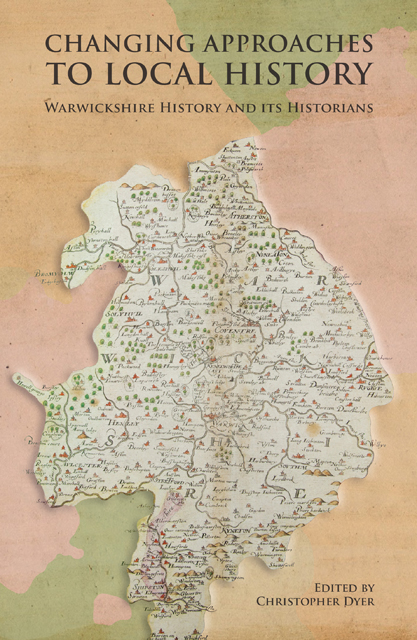Book contents
- Frontmatter
- Contents
- List of Illustrations
- Notes on Contributors
- Foreword
- Acknowledgements
- List of Abbreviations
- Introduction
- 1 The Dugdale Society: Its First Hundred Years
- 2 The Beginnings of Coventry
- 3 Was Commerce in Late Medieval Coventry Restricted by Regulation?
- 4 Studying Late Medieval Small Towns in Warwickshire 1920–2020
- 5 Rural Warwickshire in the Middle Ages: Society and Landscape
- 6 Religion, Rebellion and Red Jackets: Changing Approaches to Society and Politics in Sixteenth-century Warwickshire
- 7 Social Networks, Intellectual Affinities and Communal Harmony in Post-Reformation Warwickshire
- 8 Discovering Warwickshire’s Vernacular Architecture
- 9 Local History and the English Civil War: A View from Warwickshire
- 10 Writing Histories of the Landed Elite in Georgian Warwickshire
- 11 The Victoria County History in Warwickshire
- 12 Writing Women into the Political History of Warwickshire
- 13 Shakespeare and the Warwickshire Landscape in the Age of the Tourist
- Conclusion
- Index
5 - Rural Warwickshire in the Middle Ages: Society and Landscape
Published online by Cambridge University Press: 17 December 2022
- Frontmatter
- Contents
- List of Illustrations
- Notes on Contributors
- Foreword
- Acknowledgements
- List of Abbreviations
- Introduction
- 1 The Dugdale Society: Its First Hundred Years
- 2 The Beginnings of Coventry
- 3 Was Commerce in Late Medieval Coventry Restricted by Regulation?
- 4 Studying Late Medieval Small Towns in Warwickshire 1920–2020
- 5 Rural Warwickshire in the Middle Ages: Society and Landscape
- 6 Religion, Rebellion and Red Jackets: Changing Approaches to Society and Politics in Sixteenth-century Warwickshire
- 7 Social Networks, Intellectual Affinities and Communal Harmony in Post-Reformation Warwickshire
- 8 Discovering Warwickshire’s Vernacular Architecture
- 9 Local History and the English Civil War: A View from Warwickshire
- 10 Writing Histories of the Landed Elite in Georgian Warwickshire
- 11 The Victoria County History in Warwickshire
- 12 Writing Women into the Political History of Warwickshire
- 13 Shakespeare and the Warwickshire Landscape in the Age of the Tourist
- Conclusion
- Index
Summary
Knowledge and understanding of Warwickshire’s medieval countryside was transformed in the second half of the twentieth century. Dozens of scholars were able to make a contribution because of their enthusiasm for particular historical themes and ideas. They were assisted by an expansion of public funding in research, and also interdisciplinary approaches. The advances in research into Warwickshire’s history were part of a general academic movement to enquire into all sections of society, not just an elite, and to reflect current interest in gender and the environment. Much writing on the county’s social and landscape history connects with work on other places, including continental Europe. This survey will begin with the period 1920–45; followed by the contributions of the mid- and late twentieth century, giving special attention firstly to Beresford, Hilton and Thorpe; and then to their contemporaries and successors. The second part will relate the thinkers and writers to their own historical circumstances. The discussion is confined to the years 1100–1540, and the pre-Conquest period, though of great importance and interest, cannot be included because space is limited.
When the Dugdale Society was founded in 1920, Mary Dormer Harris’s chapter in the Victoria County History (VCH) on social and economic history, although published in 1908, still represented current understanding of the subject. She was aware of the landscape divisions between Arden and Feldon (Fig. 7). She reflected the preoccupation in her day with lord–tenant relationships by discussing villeinage and labour services, and the enclosures and depopulations of the period around 1500. She discussed the role of women. In its early years the Dugdale Society published documents useful to social historians. They included the lay subsidy (royal tax) of 1332, which contained information about the taxpaying capacity of a wide spectrum of society, and three volumes of the feet of fines, recording details of people conveying land. Court records of the late fourteenth century showed the justices of the peace dealing with violent crimes and theft, and also with excessive wages and irregular trading practices. History writing that could benefit from such documents included parish histories for the VCH by Philip Styles, though the volume for which he was local editor in the 1930s did not appear until 1945.
- Type
- Chapter
- Information
- Publisher: Boydell & BrewerPrint publication year: 2022



